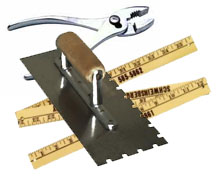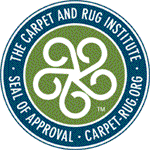| PAINTING CARPET CERAMIC FLOORING |
| QUALITY SATISFACTION CERTAINTY GUARANTEED |
Custom Home Painting & Carpet
| Ceramic Tile Installation Methods |
 |
There are many different installation methods used to install ceramic tile. We recommend that you review our "Ceramic Tile Installation" page first to find out what method you will be using. Afterwards, you can refer back to this page understanding what materials you will need. A successful installation depends on the proper use of quality installation materials or more commonly referred to as "setting materials". Choosing the correct setting materials is as important as your tile selection. When choosing your setting materials, we recommend that you use TCA or Tile Council of America approved setting materials. If they are TCA approved, you can be sure you are getting quality material that has been field proven to perform. In addition, please refer to the manufacturers' spread rate information when figuring out how much of each material you will need. This information is usually printed on the label of the product. These spread rate calculations take into account the type of tools you are using and other important factors to avoid over or under purchasing.
Thin Set
Thin set is most commonly used when installing floor tile over a concrete or similar subsurface. Thin set is a form of cement or bonding mortar. It is usually sold in 50 pound bags and is relatively inexpensive. There are some specialty types of thin set that can be used to install tile over a wood subsurface. This type of thin set can be effective as long as the wood sub-floor is constructed according to TCA recommendations. We highly recommend that if you have a wood sub-floor, you consider installing a concrete or fiber backer board prior to the tile being installed.
Grout
Grout is a setting material that you will use with any ceramic tile installation you perform. Grout is the cement that will fill the joints in between the tiles. There are two main types of grout, non-sanded and sanded. Both are available in several different colors. Non-sanded grout is used with tiles that have a grout joint width less than 1/8", and sanded grout is used with tiles that have a grout joint width of 1/8" and greater. Grout color is also an important factor. You will want to keep in mind that lighter grout colors like white and the off whites are difficult to keep clean. Even though most of the major grout manufacturers are selling grouts that are polymer modified to resist stains, when they are dirty, it is a lot more noticeable than the medium to darker colors. You may want to try to match the grout color to the darker tone in the tile. This will accent the overall look nicely. There are a few other types of grout one of them being epoxy grout, but this is extremely difficult material to work with unless you are a professional, and is almost exclusively used in industrial applications.
Organic Adhesive
Also referred to as glue, organic adhesive is used to install ceramic tile on walls, counter tops, etc. There are two basic types of adhesive. If you were going to install wall tile on standard drywall, you would use standard wall tile adhesive. If you were going to install tile over wood or a laminate counter top, you would use multipurpose adhesive. Multipurpose adhesive will bond to virtually any surface including backer boards and existing ceramic tile surfaces, providing they are prepared properly.
Latex Bonding Chemicals
Latex bonding chemicals are primarily mixed in with the thin set to increase the bond strength. They should be used when installing tile; over concrete that has been previously painted and all the paint could not be removed, on exterior installations subject to harsh weather conditions, over terrazzo floors, over some vinyl floors, and in other related situations. In most of these cases, the existing floor should also be roughed using some type of grinding equipment. In doing so you will minimize your chances of the floor lifting or "popping up" in the future. A few years ago, prior to the introduction of "polymer modified grouts", latex was also mixed into grouts to strengthen the bond and help prevent staining. But now most manufacturers advise that you don't mix any latex chemicals into the grouts because it may cause uneven color consistency.
Sealers
Sealers must be used with tiles that are not glazed such as Mexican and terra-cotta tiles. The installation process for these types of tiles, as well as the procedures used to apply the required sealers, can be quite complex. We recommend that you do some strong research prior to attempting this type of installation and make absolutely certain this is something you want to get involved with. As far as grout sealers are concerned, there are some applications where they can be beneficial such as kitchen counter tops and back splashes, since there is a lot of grease in these areas. As far as using grout sealer on a floor, we recommend that you don't. As we mentioned previously, most quality grouts are polymer modified and there is no need to use any sealer after the installation.
Cleaners
Please refer to our "Ceramic Tile Care & Maintenance" page (coming soon) to learn about the proper cleaners to use on your ceramic tile floor.
Tools
Please refer to our "Ceramic Tile Installation" page (coming soon) to learn what tools are required to properly install ceramic tile.
If you have read a lot of this information, and you're reconsidering doing the installation yourself, you may want to seek the help of a professional installer.
Free In Home Estimates - 972-596-9985 - Email Us

Custom Home Painting & Carpet Service Cities:
Dallas · Richardson · Plano · Austin · Allen · McKinney · Frisco · Flower Mound · Coppell · Highland Village
Lewisville · Carrollton · Farmers Branch · The Colony · Garland · Sasche · Rowlett · Rockwall · Wylie
Forney · Heath · Sunnyvale · Mesquite · Fort Worth · Arlington · Irving · Grapevine · Grand Prairie
Southlake · Hurst · Euless · Bedford · Bee Cave · Cedar Park · Dripping Springs · Leander
Georgetown· Lakeway · Pflugerville · Round Rock · West Lake Hills · Bastrop · San Antonio
Custom Home Painting & Carpet specializes in these Neighborhoods:
Forest Creek Estates · Hunter’s Glen · Watters Crossing · Deerfield · J. J Pearce · Fairways of Ridgeview
Stonebridge Ranch · Russell Creek Estates · Yale Park · Twin Creek · Prestonwood Hills · Glen Heather
Harrington Homeplace · Pittman Creek Estates · Ranch Estates · Whiffletree · Wentworth Estates
Fairways of Ridgeview · Willow Bend Estates · Preston Meadow · Highlands of Preston Ridge
Stonehaven Estates · Plano Trails · Chase Oaks · Carriage Hills · Hills of Indian Creek · Dallas North Estates